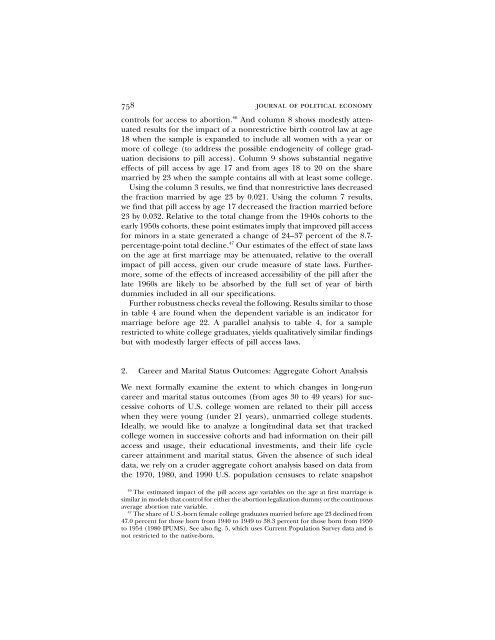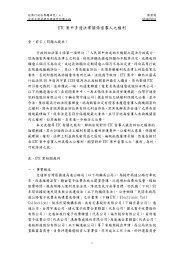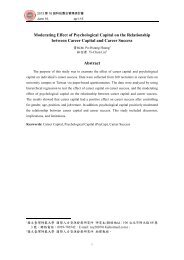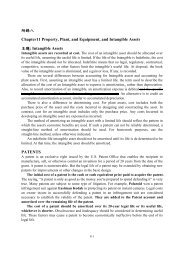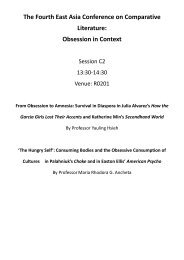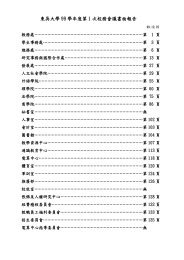The Power of the Pill: Oral Contraceptives and Women's ... - Mail
The Power of the Pill: Oral Contraceptives and Women's ... - Mail
The Power of the Pill: Oral Contraceptives and Women's ... - Mail
Create successful ePaper yourself
Turn your PDF publications into a flip-book with our unique Google optimized e-Paper software.
758 journal <strong>of</strong> political economy<br />
controls for access to abortion. 46 And column 8 shows modestly attenuated<br />
results for <strong>the</strong> impact <strong>of</strong> a nonrestrictive birth control law at age<br />
18 when <strong>the</strong> sample is exp<strong>and</strong>ed to include all women with a year or<br />
more <strong>of</strong> college (to address <strong>the</strong> possible endogeneity <strong>of</strong> college graduation<br />
decisions to pill access). Column 9 shows substantial negative<br />
effects <strong>of</strong> pill access by age 17 <strong>and</strong> from ages 18 to 20 on <strong>the</strong> share<br />
married by 23 when <strong>the</strong> sample contains all with at least some college.<br />
Using <strong>the</strong> column 3 results, we find that nonrestrictive laws decreased<br />
<strong>the</strong> fraction married by age 23 by 0.021. Using <strong>the</strong> column 7 results,<br />
we find that pill access by age 17 decreased <strong>the</strong> fraction married before<br />
23 by 0.032. Relative to <strong>the</strong> total change from <strong>the</strong> 1940s cohorts to <strong>the</strong><br />
early 1950s cohorts, <strong>the</strong>se point estimates imply that improved pill access<br />
for minors in a state generated a change <strong>of</strong> 24–37 percent <strong>of</strong> <strong>the</strong> 8.7-<br />
percentage-point total decline. 47 Our estimates <strong>of</strong> <strong>the</strong> effect <strong>of</strong> state laws<br />
on <strong>the</strong> age at first marriage may be attenuated, relative to <strong>the</strong> overall<br />
impact <strong>of</strong> pill access, given our crude measure <strong>of</strong> state laws. Fur<strong>the</strong>rmore,<br />
some <strong>of</strong> <strong>the</strong> effects <strong>of</strong> increased accessibility <strong>of</strong> <strong>the</strong> pill after <strong>the</strong><br />
late 1960s are likely to be absorbed by <strong>the</strong> full set <strong>of</strong> year <strong>of</strong> birth<br />
dummies included in all our specifications.<br />
Fur<strong>the</strong>r robustness checks reveal <strong>the</strong> following. Results similar to those<br />
in table 4 are found when <strong>the</strong> dependent variable is an indicator for<br />
marriage before age 22. A parallel analysis to table 4, for a sample<br />
restricted to white college graduates, yields qualitatively similar findings<br />
but with modestly larger effects <strong>of</strong> pill access laws.<br />
2. Career <strong>and</strong> Marital Status Outcomes: Aggregate Cohort Analysis<br />
We next formally examine <strong>the</strong> extent to which changes in long-run<br />
career <strong>and</strong> marital status outcomes (from ages 30 to 49 years) for successive<br />
cohorts <strong>of</strong> U.S. college women are related to <strong>the</strong>ir pill access<br />
when <strong>the</strong>y were young (under 21 years), unmarried college students.<br />
Ideally, we would like to analyze a longitudinal data set that tracked<br />
college women in successive cohorts <strong>and</strong> had information on <strong>the</strong>ir pill<br />
access <strong>and</strong> usage, <strong>the</strong>ir educational investments, <strong>and</strong> <strong>the</strong>ir life cycle<br />
career attainment <strong>and</strong> marital status. Given <strong>the</strong> absence <strong>of</strong> such ideal<br />
data, we rely on a cruder aggregate cohort analysis based on data from<br />
<strong>the</strong> 1970, 1980, <strong>and</strong> 1990 U.S. population censuses to relate snapshot<br />
46<br />
<strong>The</strong> estimated impact <strong>of</strong> <strong>the</strong> pill access age variables on <strong>the</strong> age at first marriage is<br />
similar in models that control for ei<strong>the</strong>r <strong>the</strong> abortion legalization dummy or <strong>the</strong> continuous<br />
average abortion rate variable.<br />
47<br />
<strong>The</strong> share <strong>of</strong> U.S.-born female college graduates married before age 23 declined from<br />
47.0 percent for those born from 1940 to 1949 to 38.3 percent for those born from 1950<br />
to 1954 (1980 IPUMS). See also fig. 5, which uses Current Population Survey data <strong>and</strong> is<br />
not restricted to <strong>the</strong> native-born.


